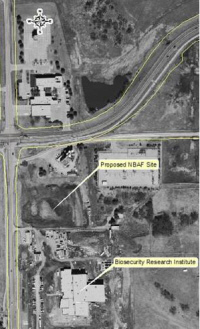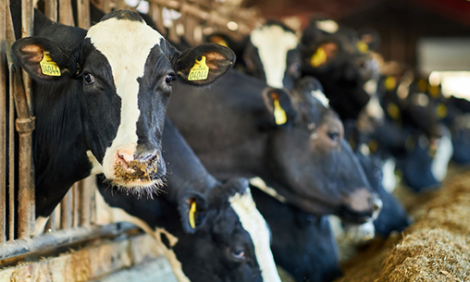



NBAF: Securing a Threat, or Threatening a Security?
After months of deliberation, Manhattan, Kansas, has been chosen as the destination of the new US National Bio and Agro-Defence Facility (NBAF), writes Adam Anson, reporting for TheCattleSite. But what actions will this new facility undertake and what consequence will it have on the future of American agriculture?
Photo: Homeland Security
As the ageing Plumb Island facility comes to the end of its operational lifespan the US looks to build a new, more advanced facility to take its place.
This new facility is summarised by the US Homeland Security as: "an integrated facility for studying diseases categorized as foreign animal diseases and zoonotic diseases (those that can be transmitted from animals to humans)". Ultimately it is aimed at protecting the largest industry and employer in the United States - agriculture - which currently generates more than $1 trillion in economic activity annually, including more than $50 billion in exports.
The risks that pathogens pose to this monumental industry are continuously growing. The global marketplace, increased imports of agricultural products, and growing numbers of international travelers to the United States have increased the number of pathways for the introduction of foreign and invasive agricultural pests and diseases.
Homeland Security believes that the modern, high-security NBAF will "enhance US capacity to assess potential threats to humans and animals alike, serving as livestock laboratory capable of developing countermeasures for foreign animal diseases". The research proposes to understand how these diseases enter the animal, what affects they have and how suitable counter measures can be applied to tackle them.
Homeland Security believes that this will not only bring protection to humans and animals, but will also serve to boost animal welfare by preventing needless suffering. The economic safeguard that farmers will receive against biological disasters are priceless and their aversion to terrorist attacks on US grounds will also serve a relevant function to US national security.
Things to Come: from the Microscopic to the Metropolis
The NBAF will be located adjacent to the K-State campus. The location was chosen because it is a region rich in animal infectious disease research, pharmaceutical production, and work force availability.
Homeland Security called the the Kansas City bioscience industry an internationally-recognized leader in the animal health arena. Its strength is in its numbers: the region is home to 165 life science companies, with 37 focused on protecting and securing animal health. Within the $14.5 billion animal health industry, more than 40 per cent of the U.S. sales and 26 per cent of worldwide sales are those of companies having a presence in the Kansas City area.
The economic impact to Kansas will be huge. According to NBAF in Kansas, an organisation that lobbied for the introduction of the facility in Manhattan, an estimated $1.5 billion will be generated in local communities during the first 20 years of the projected 50-year lifespan, whilst an estimated 1,000 to 1,500 construction jobs will be created over the four-year construction period of the facility. These high-paying positions will generate additional money within other businesses in the community.
"This might very well be the most important thing that has happened to Kansas State University in the entire history of the university," said K-State President Jon Wefald in response to the decision. "Never before in the history of Kansas has a national federal laboratory of this magnitude been sited in the state. We are talking about a half-billion dollar animal health facility that will be the finest laboratory of its kind in the entire world. After all, there will be hundreds of world-class scientists doing research in this facility."
However, not everybody is happy about the decision. Since the idea was first conceived for the NBAF it has come under widespread criticism. Attempting to address some of these concerns The Homeland Security published the document: Final Environmental Impact Statement to evaluate the environmental affects that such a facility might present to its surroundings.
Simulation and Real Life: The Risks of NBAF
Visual air, and noise pollution were all factored into the report. Also included were affects on the surrounding landscape, on the water supply and on local biological resources and wildlife. The facility will also produce unwanted hazardous, toxic and even radiological material waste. The report claims that operation of the NBAF would generate between 25 million and 30 million gallons of wastewater per year.
However, of most concern for campaigns against the NBAF is the risks associated with the release of a pathogen proposed for study within the NBAF. The document acknowledged that a such risks were shown to present "a hazard to workers and a potential for release from the facility".
Whilst Plumb Island was an isolated facility that posed little threat to American agriculture, the new facility will be built on mainland American soils - and in close vicinity to livestock operations. If such a pathogen was to be released, the threat to biological safety could be disastrous.
Currently, the diseases that are of the greatest threat to American agriculture are the ones which are to be studied in the facility. These include Classical Swinre Fever; African Swine Fever, Fift Vally Fever; Contagious Bovine Pleuropneumonia; Japanese Encephalitis Virus; Nipah Virus; Hendra Virus; and most worryingly, Foot and Mouth Disease.
The Homeland Security report focussed specifically on the risk and consequence of a release of Foot and Mouth Disease due to its "highly infectious nature and potential economic impact". The hazard analysis included in the Health and Safety section of the EIS, concluded that the likelihood of a release of Foot and Mouth Disease virus was extremely low. However, history has shown that even the most stringent precautions often fall to this disease.
In April of 2008 the Homeland Security made public that the only ever US laboratory to test the highly-contagious Foot and Mouth Disease had experienced several accidents and near outbreaks. "A 1978 release of the virus into cattle holding pens on Plum Island, N.Y., triggered new safety procedures", reported the news association Usagnet. "While that incident was previously known, the Homeland Security Department told a House committee there were other accidents inside the government's laboratory", it continued.
More worrying was the UK Foot and Mouth outbreak of 2007 that came from a Pirbright site shared by the government's own Institute of Animal Health research facility. The source of the outbreak was tracked to a leaking pipe. Although the incident was considered to have been successfully dealt with - the disease cost the UK sheep industry £50 million alone.
However, by comparison with the 2001 outbreak, this latest bout was insignificant. Britain's 2001 Foot and Mouth Disease epidemic devastated the livestock industry. The outbreak was only brought under control when the government slaughtered 6 million sheep, cows and pigs.
Concerned with these incidents, a US government report entitled: Crimson Sky, was produced last year with the intention of evaluating how a Foot and Mouth outbreak might affect America if it was to be released on the mainland. To produce the report the Homeland Security Department, combined commercial satellite images and federal farm data to show the proximity to livestock herds of locations that have been considered for the new lab.
"Would an accidental laboratory release at these locations have the potential to affect nearby livestock?" asked the nine-page document. It did not directly answer the question, said a Newsvine report.
According to the news organisation: "The simulated outbreak ended with fictional riots in the streets after the simulation's National Guardsmen were ordered to kill tens of millions of farm animals, so many that troops ran out of bullets. In the exercise, the government said it would have been forced to dig a ditch in Kansas 25 miles long to bury carcasses. In the simulation, protests broke out in some cities amid food shortages."
The protection that the NBAF will provide to the livestock industry must be weighed up against the threat that the NBAF facility poses to the industry. Although both have huge implications - and precisely for that reason - neither argument can be dismissed. Despite it was a government facility that brought about the latest FMD outbreak in the UK, it was vaccines from the same facility that actually helped to bring it to a successful conclusion. One thing remains certain, the race for biological protection will not come to an end any time soon, but the pace is certainly increasing.
January 2009


